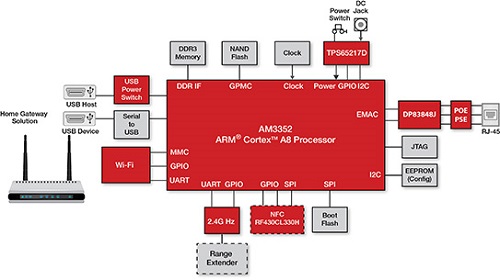The Internet of Things (IoT) Gateway from Texas Instruments bonds building/home energy systems that use ZigBee or other low-power RF (LPRF) technologies to any Wi-Fi router. This subsequently allows for monitoring and control of smart energy devices, or home automation systems, by smartphone or tablet. In essence, the solution bridges ZigBee and Wi-Fi or Ethernet signals to enable applications such as real-time energy monitoring and interaction. The robust nature of the solution allows the integration of additional communication interfaces such as Bluetooth and NFC for smart phone pairing or prepayment.
At the heart of the solution sits a powerful Sitara™ processor based on the ARM®Cortex™-A8. It comes preloaded with Linux, to create an open source environment that encourages vast software and firmware customization possibilities. Simultaneously, the Sitara processor’s ability to run various software communication stacks encourages faster development time, eases the coexistence testing and seamless adaption to various application profiles (lighting, home automation, smart energy); communications, data processing and applications are managed locally instead of relying on intelligence in the cloud. Furthermore, the Sitara processor portfolio is scalable from 300 MHz to 1 GHz based on customers' performance and cost needs.

The IoT Gateway is the essential component propagating the integration of smartphones and tablets with smart electricity systems for two reasons. First, ZigBee has established itself as the most prevalent chipset in U.S. smart electricity meters, responsible for running Smart Energy Profiles (SEP) that communicate with Home Are Network (HAN) devices such as In-Home displays (IHDs), thermostats, and smart appliances. And second, Wi-Fi and Ethernet are the most prominent Internet interface methods in both homes and buildings.
The IoT Gateway/Smart Hub Solution
The key advantage behind TI's IoT Gateway solution can summed up by the following phrase: it saves time and money by only using tested and interoperable components from a single supplier. These include reference designs of TI'sCC2530 ZigBee system-on-chip (SoC), WiLink combo-connectivity solution Wi-Fi and Bluetooth, TI's RF430 and NFC SoC, the TPS650250 power management integrated circuit , DP83848 Ethernet PHY, TUSB2036 USB interfaces solutions, as well as the 800 MHz Sitara AM3352 processor. All the hardware and software required to build a home gateway system is included.
AM3352 Sitara Processor
The Sitara AM3352 is a cost-optimized, scalable processor with cohesive system connectivity solution, making it ideal for the development of IoT applications. With pin-to-pin compatible scalability to graphics enabled processor, it can also aid display based gateway solutions with support for advanced user interface. The AM335x processor includes support for a robust set of software solutions that are available for free download on ti.com for Linux and Android. With access to affordable and flexible development tools, customers can easily migrate from a microcontroller (MCU)- or ARM9-based solution or cost optimize you current ARM Cortex-A8 design.
CC2530
The CC2530 is a complete system-on-chip (SoC) solution that enables the construction of robust network nodes with very low total bill-of-materials costs (BOM). CC2530 is specially designed for IEEE 802.15.4, ZigBee and RF4CE applications, combining the top performing 2.4-GHz IEEE 802.15.4 Compliant RF transceiver with the industry-standard 8051 MCU, in-system programmable flash memory, 8 KB RAM, and more. Four varieties of CC2530 are available depending on the respective amount of flash memory needed; these range from the CC2530F32/64/128/256, with 32/64/128/256 KB of flash memory.
Numerous operating modes are featured in the CC2530, suiting it for systems dependent on ultralow power consumption. Short transition times between operating modes low energy consumption even further.
WL1835MOD Wi-Fi
TI's WiLink™ 8 module family provides Wi-Fi® and Bluetooth® integration into embedded applications based on TI's Sitara processor. The pre-certified modules provide faster time-to-market and lower manufacturing costs – all in a power-optimized design. WiLink 8 solutions are designed for wireless connectivitiy requiring high-throughput, extended range, Wi-Fi and Bluetooth coexistence (if using WL183x modules), The necessary Linux and Android high-level operating systems are provided courtesy of TI, at no extra cost. Minimal RF expertise is required.
RF430
The NFC Interface Transponder RF430CL330H component is chiefly responsible for incorporating NFC as part of the overall communication interface. The device is NFC Tag Type 4, meaning, it combines a wireless NFC interface and a wired SPI or I2C interface in order to connect with a host device. Additionally, the NFC connection can be handed over to an alternative carrier such as Wi-Fi or Bluetooth Low Energy courtesy of the fact that the NDEF message in the SRAM may be written and read from the SPI or I2C serial communication interface.
TPS650250
TPS650250 power management integrated circuit is an IC specifically designed for applications powered by one Li-ion or Li-polymer cell and require multiple power rails. Three built-in and efficient step-down converters provide core voltage, peripheral, I/O and memory rails in a process based system. Moreover, the component integrates two general-purpose 200-mA LDO voltage regulators, which can be enabled with an external input pin. The regulators operate with an input voltage ranging between 1.5 and 6.5 V, ensuring they can be supplied directly from the battery or one of the step-down converters.

Orderable part numbers, in stock at Mouser:
• WL1835MOD Wi-Fi
• CC2538 ZigBee Cortex M3 based System On Chip
• RF430CL330H
• DP83848J
• TPS65217D

For extra IoT Gateway information visit TI.com
Advertisement
Learn more about Texas Instruments





